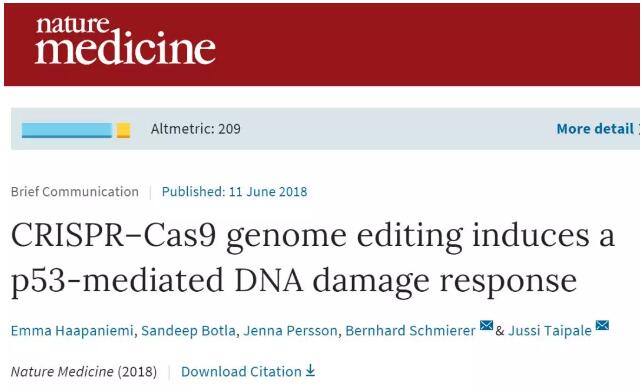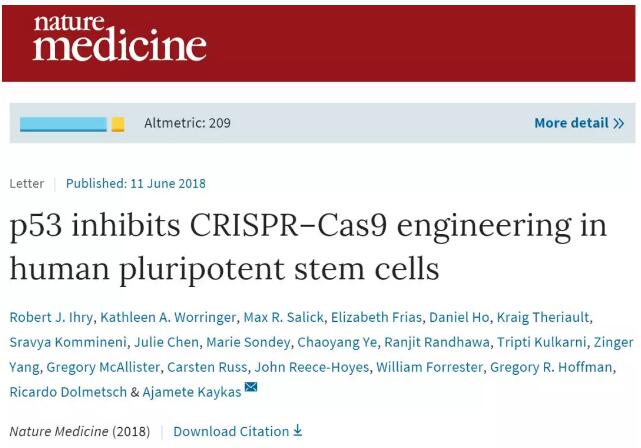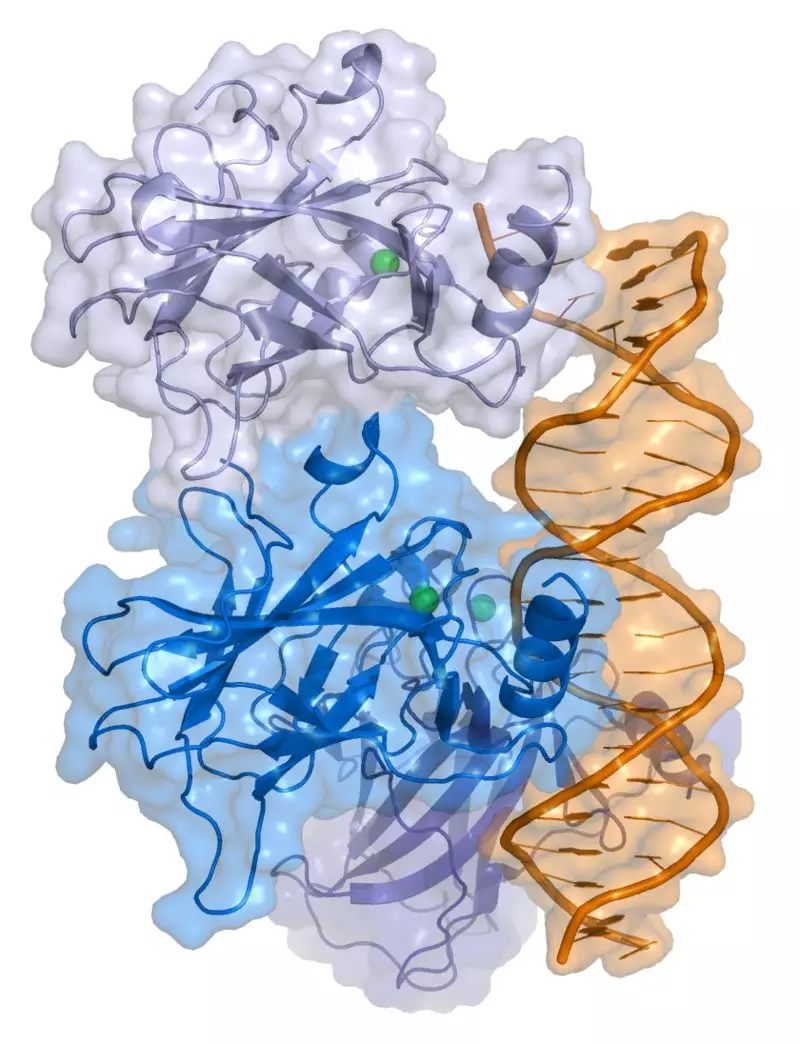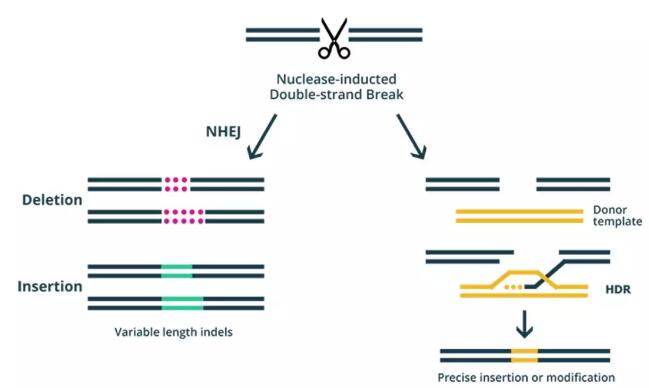Release date: 2018-06-14
On June 11, Nature Medicine published two papers on the effect of the tumor suppressor protein p53 on the gene editing of CRISPR in human pluripotent stem cells: DNA double-strand breaks caused by CRISPR gene editing activate p53, causing human Apoptosis of pluripotent stem cells. The cells that were finally "screened" for survival are likely to have defects in p53 function, a feature of many malignancies. Such cells are likely to have a very high risk of carcinogenesis after transplantation into the body, although no direct experiments have confirmed their carcinogenicity.
These two articles are once again a wake-up call for the security of CRISPR. This reminds us that there is still a way to go before applying to the human body. Future use of other types of Cas9 protein, or selective temporary inhibition of p53 activity, may solve this current thorny problem.
The technology of CRISPR was once considered to be promising, and because of its high precision and rapid characteristics, it has been favored by countless people, hoping it will bring new dawn to gene therapy. However, with the development of various experiments, more and more scientists have begun to question the side effects of this technology.
Following an article published in the Nature issue of Nature Methods at the end of May last year, "Gene editing technology is likely to cause hundreds of uncertain genetic mutations in the genome" (retracted on April 27 this year), June On the 11th, two journals published in Nature Medicine have repeatedly reported that human pluripotent stem cells, which have been successfully edited by CRISPR-Cas9, may be at risk of cancer. The carcinogenicity of CRISPR-Cas9 has not been directly validated, but the study sparked scientists' discussion about the need for optimization of the technology.


Unlike previous results based on mouse data from Nature Methods, both of these were experimental results from human pluripotent stem cells, which undoubtedly gave the company a pioneer in the development of CRISPR gene editing therapies. Affected by this, the price of CRISPR Therapeutics plummeted on June 11 and has not seen a significant turnaround to this day.
According to the paper, researchers at the Karolinska Institutet and Novartis in Sweden found that pluripotent stem cells successfully edited using CRISPR-Cas9 are likely to have p53 defects, which will increase the risk of cancer. According to them, "these genes edit cells as if they were time bombs."
Prior to this challenge, CRISPR technology had escaped two robberies. First, the technology was accused of surprisingly high target rate, but the complaint was withdrawn in April 2017. Second, the human body's immune response to Cas9 exists. The problem was eventually perfunctory as "solvable." However, for the results of the experiments published on June 11, we are still unable to make more confirmation.
Sam Kulkarni, CEO of CRISPR Therapeutics, said the results "look plausible." Although these studies have focused on the use of normal genes to replace the use of disease-causing genes rather than DNA sequence shepts, he said: "This is where we should pay attention, especially now that CRISPR therapy is being applied to more and more diseases. We want to make sure that these edited cells don't become cancer cells after being returned to the body." Another leading scientist in the field (which has a close relationship with a gene editing company, so it is inconvenient to disclose the name), think this The two studies were “very shocking†and expressed concern about the CRISPR therapy that had neglected this aspect.

Figure | CRISPR Several ways of editing (Source: CRISPR Therapeutics)
On the other hand, Erik Sontheimer of the University of Massachusetts Medical School said that the first draft of the article from Novartis had been pre-printed since last summer, but the experts in the CRISPR community were not panicked. ". His own research direction is to explore the novel enzymes and off-target effects of CRISPR technology. He also mentioned: "This is a noteworthy thing, but I don't think this means that CRISPR technology cannot be applied to disease treatment."
The Karolinska and Novartis groups tested CRISPR in human retinal cells and pluripotent stem cells, respectively. The experimental results in the two cells are similar, which has attracted the attention of researchers. The typical CRISPR-Cas9 works by cutting the two strands of a double-stranded DNA strand, which leads to the activation of the intracellular "first aid gene" p53: repairing DNA breaks or causing cells to "suicide." However, in either case, the result of p53 activation will make CRISPR technology ineffective because the DNA strand after cleavage is not rejoined or cell death. The Novartis team also demonstrated that activation of the p53 gene reduced the efficiency of CRISPR in pluripotent stem cells by one-seventeenth. This probably explains why CRISPR technology is extremely inefficient, and even with the help of viral vectors, only a very small number of cell genomes have been successfully edited.

Figure | Tumor suppressor protein p53 (Source: Wikipedia)
"We found that CRISPR-Cas9 cuts the genome and activates p53," said Emma Haapaniemi, the first author of the Karolinska study group. "This makes genetic editing more difficult."
Looking at it from another angle, cells can be successfully edited by CRISPR technology because of the dysfunction of p53 that causes cells to lose their ability to repair DNA and to lose programmed death. But the problem is that dysfunction of p53 also means cancer, and this is not an accidental phenomenon: almost half of ovarian cancer patients, 43% of colorectal cancer patients, 38% of lung cancer patients, nearly one-third of pancreatic cancer, Patients with gastric cancer and liver cancer, as well as a quarter of breast cancer patients, have p53 mutations.
The original research goal of the Novartis team was to explore how to increase the efficiency of CRISPR editing of pluripotent stem cells, because pluripotent stem cells have the potential to differentiate into all types of cells, so that gene editing can be used to treat a wide variety of diseases. Ajamete Kaykas, a neuroscientist at the company's research institute in Cambridge, Mass., successfully addressed the efficiency of CRISPR technology editor pluripotent stem cell DNA by 80%. However, unfortunately, most of the cells eventually failed to survive. Surviving cells are likely to have p53 dysfunction, which can lead to tumor risk. This conclusion was confirmed in the p53 defect experiment in the paper.

Figure | Most of the p53-deficient human pluripotent stem cells can "snap" the CRISPR gene editing, while most of the common ones are apoptotic (Source: Nature Medicine)
Therefore, the Novartis group concluded: “It is very important to ensure that p53 functions before and after gene editing.†Karolinska’s team also believes that p53 and other related issues need to be reviewed when developing CRISPR editing techniques using CRISPR-Cas9 technology. The gene still has normal function.
However, this finding about p53 does not mean that CRISPR is "played out." First, Bernhard Schmierer, a biochemist at the Karolinska Institute, believes that “these two articles present only initial data. It is not clear whether this finding is true in the cells used in clinical trials.†Second, p53 The problem may be alleviated by the use of other DNA cleavage enzymes (rather than Cas9). In addition, gene editing in other pathways may not involve p53 activation.
There are two ways for CRISPR to edit genes. The first is called non-homologous end joining (NHEJ), or damaging repair, which cuts a large segment of the causative gene, complemented by non-homologous bases. This is the method used by CRISPR to treat sickle cell disease. The second type, called homologous recombination repair (HDR), is also called corrective gene repair, which is to cut off the disease-causing gene and fill it with homologous normal bases. Currently, several university laboratories are working to use HDR to treat diseases such as Duchenne Muscular Dystrophy.

Figure | Non-homologous end joining and homologous recombination repair (Source: Emendobio)
Haapaniemi said that in normal and mature cells studied in their group, invasive repair "also occurs when p53 is activated." This is great news for projects using the NHEJ pathway, such as CRISPR Therapeutics sickle cell disease. . However, the US Food and Drug Administration (FDA) suspended human research on CRISPR Therapeutics sickle cell disease in May. However, the discovery of p53 should also not affect the study of amyloidosis by Intellia Therapeutics and Regeneron.
According to a related scientist, the University of Pennsylvania's CRISPR technology edited T cells to fight tumors in a clinical trial, there is no problem with p53 dysfunction. Other CRISPR gene editing protocols that do not break the DNA double-strand should not have this problem, such as the technique of Beam Therapeutics, designed by Harvard University's Liu Ruqian, to replace the mutated base with the correct base.
However, the p53 problem does affect some of the treatments developed by companies that use HDR methods, including those developed for diseases such as glycogen storage, cystic fibrosis, and severe complex immunodeficiency.
In addition, the use of CRISPR technology in stem cells has also become a thorny issue. The Novartis team has shown that p53 disorders appear to be a requirement in both NHEJ and HDR. This suggests that there is a disabling p53 in successfully edited stem cells, which can lead to cancer.
Seeing this, maybe you have questions, why haven't the cells that have been successfully edited by CRISPR have been reported to cause cancer? Why is there no carcinogenicity in the test in mice?
Haapaniemi of the Karolinska research group explained that this is because this effect occurs in large trials, such as their group and the Novartis group, and is easily overlooked in small studies because people focus on only one type of cell. Edit a gene. When asked about other scientists, she said: "It seems that other research groups have not yet discovered the role of p53 in gene editing."
Jacob Corn, of the University of California at Berkeley, said that although their labs had noticed signs of p53 mutations in several experiments, they did not get anything when they tried to track the growth effects of these blood stem cells after editing. However, he also indicated that he has no reason to doubt the discovery of the Novartis group in pluripotent stem cells.
As for why no one has ever reported that CRISPR gene editing can cause cancer in mice, Haapaniemi said: "This question is good," one of the reasons may be that "experimental mice generally sacrifice earlier" and the tumor is too late to occur.
However, Jacob Corn said he and other researchers "have been exploring whether it will cause cancer, but no one has found relevant evidence yet." But in any case, he still feels that these two articles are "very important because it reminds each of them." People, genetic editing is not a miracle."
Overall, as more and more research indicates that there are drawbacks to CRISPR technology, there is still much to go to use this technology safely and efficiently for clinical treatment.
Source: DeepTech Deep Technology (micro signal mit-tr)
Whether it's from sleeping weird, working out too hard, or sitting hunched over for hours staring at your computer, most of us have dealt with kinks in our necks from time to time. According to a peer-reviewed article from Marco Funiciello and Zinovy Meyler, Doctors of Osteopathic Medicine, one of the best ways to soothe aches and pains in your neck is through massage therapy.
While going to a massage therapist can be a relaxing experience, it can also be quite expensive. So if you don't have the time or money to get a professional massage, investing in a portable, at-home neck massager is a cost-effective alternative. The handy gadgets can knead out tight knots and melt stress away with ease.
There are many kinds of neck massagers on the market, including portable handheld models, devices that wrap around your neck, and even manual massager rollers. Some boast special features like adjustable heating controls so you can apply heat therapy to painful spots, while others are designed to target pressure points for migraine relief.
Deep Muscles Massager,3D Neck Massager,Electric Back Massagers,Heated Neck Massagers
Ningbo Shuangtuo International Trade Co., Ltd. , https://www.nbst-sports.com